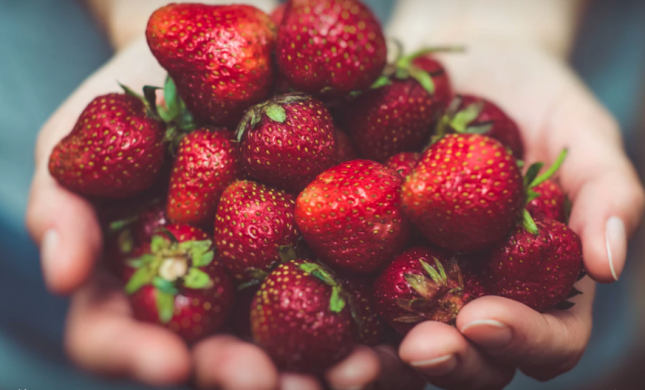20 June 2017 – by Jasmyn Druge
Pick-Your-Own Locations
Category: Seasonal Activities
Tags: pick your own, you pick, berries, vermont farms, vermont tourism, things to do
Related Places: Adam’s Berry Farm , Boyd Family Farm , Cedar Circle Farm & Education Center , Champlain Orchards and Cidery , Hartshorn Farm Market , Isham Family Farm LLC , Knoll Farm , Last Resort Farm , Lewis Creek Farm , Merck Forest and Farmland Center , Norris Berry Farm , Paul Mazza Fruit and Vegetables , River Berry Farm
There’s no better way to truly appreciate the freshness of Vermont berries than going and picking them yourself. Below is a list split up by county to encourage you to go pick-your-own this season! Be sure to always call the farm ahead to verify their pick-your-own hours.
Addison
From June to November, anyone and everyone is welcome to come picking at Champlain Orchards.
Late June: Cherries (Sweet and Tart)
Early July: Berries (Blueberries, Elderberries, Raspberries)
Mid July: Currants
Late July: Golden Plums
Early August: Green Plums
Mid August: Peaches, Asian and European Pears
Late August: Early Apples, Peaches, Pears
Hours: 10:00 am – 4:00 pm
Phone: (802) 897-2777
One of the first Vermont farms to offer organic pick-your-own strawberries, Last Resort Farm is a great place to pick berries. With experience growing strawberries since 1983, Sam and Eugenie’s organic production methods guarantee the tastiest, safest-to-eat fruit.
Hours: Thursday & Friday: 8:00 am – 12:00 pm; Saturday & Sunday: 8:00 am – 4:00 pm
Phone: (802) 453-2847
June is the month for strawberries. They start the month with strawberries from their high tunnel and end the month with outdoor strawberries. Somewhere along the way they will be open for pick-your-own. Traditionally, strawberry season started with the first day of Summer, June 21st, and lasted through July 4th or even mid July. In the last few years, the season has moved earlier so that they have often started picking by June 12th or so, but it also means that they rarely have any berries left on the 4th of July.
Please call for pick-your-own hours!
Phone: (802) 453-4591
Bennington
Raspberries, blackberries, black raspberries, and blueberries are all a part of pick-your-own at Merck Forest and Farmland Center from July to mid-September.
Hours: 9:00 am – 3:30 pm
Phone: (802) 394-7836
Chittenden
The 2017 season will be opening with pick-your-own Summer raspberries in early July followed by blueberries in mid July. If you are looking for fresh pre-picked berries (i.e.strawberries) go visit them at the farm, stop by and say hello at the Burlington Farmers Market on Saturdays, or enjoy the berries at local markets and restaurants throughout Chittenden County.
Hours: 9:00 am – 6:00 pm
Phone: (802) 578-9093
Their berry fields, established in 2003, include early and mid-summer-ripening blueberries, and summer and fall raspberries. Self-serve berry picking is available from dawn until dusk. Quart and pint containers are provided.
Blueberries- early July and August
Summer Raspberries- July
Fall Raspberries- September and October
Hours: 8:00 am – 7:00 pm
Phone: (802) 872-1525
Strawberries, blueberries, raspberries.
Call for Pick-Your-Own availability!
Phone: (802) 453-3793
Call for hours and more information!
Essex: (802) 879-3760
Colchester: (802) 879-0102
Franklin
River Berry Farm’s berries are grown using organic and Integrated Pest Management (IPM), practices that help protect you and the environment. The organic strawberries are available as pick-your-own and pre-picked starting about the third week in June through the first week in July. Organic fall-bearing raspberries mid-August through September. They love the serendipitous meeting of neighbors in the patch.
Hours: 8:00 am – 6:00 pm
Phone: (802) 849-6853
Orange
They have a variety of pick-your-own options throughout the season including certified organic berries, flowers and herbs, and pumpkins.
Strawberries: 3 weeks, June into July
Blueberries: 3 weeks in July
Herbs: June-September
Flowers: July-September
Hours: Monday – Saturday: 10:00 am – 6:00 pm; Sunday: 10:00 am – 5:00 pm
Phone: (802) 785-4737
Orleans
Berry Creek Farm is registered organic as well as Animal Welfare Approved.
A Community Supported Agriculture (CSA) program, a Pick-Your-Own program, and From-the-Farm sales are available. We are accepting pre-orders for Grass Fed Beef.
The CSA allows you to support your local farmer while receiving “real food.” Our Pick-Your-Own (strawberries, peaches, and grapes) is a wonderful family outing. From-the-Farm sales are as simple as a phone call to Larry.
Phone: (802) 659-3879
Washington
A certified organic Vermont farm producing and selling delicious, healthy vegetables and fruits from their roadside farm stand. CSA shares and pick-your-own strawberries and blueberries are also available.
Call for hours!
Phone: (802) 279-8054
The pick-your-own blueberry season is every July and August. Keep checking their site or call for more information!
Phone: (802) 496-5685
Windham
Boyd Family Farm offers both pre-picked and U-pick blueberries. You can enjoy a fun-filled jaunt to their pick-your-own blueberry field. So bring your buckets and head over to their blueberry farm.
Hours: 9:00 am – 5:00 pm
Phone: (802) 464-5618
Source: Dig in VT Trails


